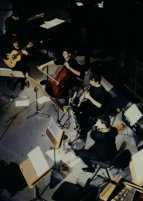»Stadtpfeiffer«
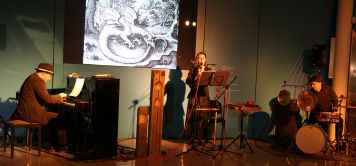 (left to right)
(left to right)
Hans-Joachim Hessler - Composition & Piano
Petra Naethbohm - Barock Flute & Barock Oboe
Oliver Birk - Drums & Percussion
»He [Hessler] was inspired by the music of the [original] Duisburg "Stadtpfeiffer" of the 12th to 18th century, combining it with modern music. [...] The audience is excited.« Sarah Schröer López in WAZ 25.04.2016).
»The extraordinary fact […] is that Hessler confronts and combines the music of the late Middle Ages, the Renaissance and the Baroque with that of today.«(Rheinische Post, 26.04.2016).
»The "Stadtpfeiffer" [waits] view themselves in the tradition of the Ruhr region, which in their eyes starts before the age of coal and steel, when half a millennium ago trade, science and culture formed a triad between Duisburg and Dortmund. Thus they forge a connection to the music virtuosos of the late Middle Ages and the Renaissance. […] 120 listeners were enthusiastic about the music.« (Rheinische Post vom 10.11.2015).
»With the ensemble "Stadtpfeiffer" the Duisburg composer, organist and pianist Hans-Joachim Hessler approaches the city of Duisburg as "Gateway to the Dutch-Burgundian Art."
In a fantastic way he developes a music for organ (pipes), piano, recorder flute / oboe and percussion, based on the Duisburg "Stadtpfeifer" [waits] of the 14th to 16th century.
Who was this Master Wilhelm, who probably worked in Duisburg for more than 30 years during the 14th century and was repeatedly invited by other cities as a guest musician?
What kind of music performed Master Johann in Duisburg during the 15th century, being only called "Lautenschläger" [lute beater] by everyone? How might the "Turmbläser" [tower brass player] Liefappel have felt when, in 1467, he was jointly responsible for the Salvator Tower burning down because he fell asleep and could not warn the citizens of Duisburg in time? Master Arndt Gardtz, also called "der Blinde" [the blind man], lived in a house on Beek street at the beginning of the 16th century. How will his music have sounded? Then there was the town minstrel Walter Goldenberch, the Dutch-born trumpeter Joest Collet from Middelborch (Middelburg) and the drummer Gerhard Flamm and many minstrels more...
Hessler wouldn't be Hessler if he would not confront the music of the late Middle Ages and the Renaissance with today's music. With raising the question "What kind of music do the 'Stadtpfeifer' play today?", he quasi puts himself into the centuries-old tradition of the city minstrels.« (excerpt from the program of the Platzhirsch-Festivals, 16.08.2015).
Sound Sample 1: Magistro Wilhelmo ludenti super citharam (excerpt)
Master Wilhelm was presumably in the service of the city of Duisburg from 1359-1394. The title of the composition refers to the following entry in the Duisburg city accounts: "1394 - feria quinta post festum Conceptionis b. Marie virg. magistro Wilhelmo ludenti super citharam" (In 1394 on thursday after the feast of the Conception of the Blessed Virgin Mary Master Wilhelm played the harp).
Sound Sample 2: Master Johan luytensleger (excerpt)
For Master Johan, the following entry appears in the Duisburg city accounts: "1421 - meister Johan luytensleger dys avends opper sant Marien" (In the year 1421 Master Johan, the "Lautenschläger" [lute beater] played the evening at the sacrifice of Mary).
Sound Sample 3: Tower Fire! (excerpt)
"In 1467 […] three bells, which were to be hung in the tower of the great Salvator church, were cast in the churchyard; and on Palm Sunday of this year the old tower of this church burnt down in a conflagration, and the bells melted. This conflagration was caused by the carelessness of the drunk "Thurmwlächter" [tower brass player] Adolf Liefappeler, who had fallen asleep and neglected his light." (Dr. August Christian Borheck, professor of history at the old University of Duisburg in his "History of the town Duisburg at the Rhine", published in 1800, p. 55.).
Ab-Art-Ensemble
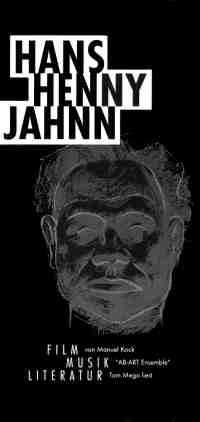 Hans Henny Jahnn
Hans Henny Jahnn
Manuel Kock, film
Ab-Art-Ensemble:
Gesine van der Grinten, mezzo-soprano
Hans-Joachim Hessler, piano
Ulrich Blomann, bass clarinet, saxophone
Tom Mega, reading
1993/94
»Among the major German-speaking authors of the first half of the 20th century, Hans Henry Jahnn (1894-1959) is still the least well known. His novel Perrudja,
which demonstrates strong linguistic power, and the pictorially-visionary rampant novel trilogy Fluß ohne Ufer [river without bank] are the German equivalent to Proust's, Joyce's and Faulkner's novels,
which have long been recognized as world literature. And Jahnn wasn't only a writer. He also set himself apart as a master-builder, organ specialist and founder of a denomination, as an agriculturist, breeder of horses and hormone scientist.
The last years of his life, finally, were marked by his unconditioned fight against the atomic arming of the Federal Republic of Germany,
by his warning of the atomic threat to humanity. Everything that Jahnn thought, did and wrote, sprung from his consciousness of the unity of creation, the harmonical order.
He lived against his time and could, even should for this reason be considered the writer, the witness of our own affliction and agony of the real, which takes place today« (Hoffmann & Campe)
The choice of instrumentation of the ensemble gives an ideal opportunity to realise the crossing of frontiers. With the saxophone, there stands on the one hand an instrument which has established itself in popular music.
On the other side stands classical singing, a position which is excellently filled with the adventurous mezzo sophrano Gesine v.d. Grinten. The keyboard instruments form the connective element.
The idiosyncratic instrumentation of the trio calls for interesting, diverse and so far unheard acoustic colours. As early as during its founding year, the Ab-Art-Ensemblewas awarded a prize at the Krefeld Gang-Art-Festival
for originary music, literature and art with respect to its idiosyncratic way of dealing with texts by Hans Henny Jahnn.
Sound example 1: Claude and the unequal beat
Sound example 2: S.L.Y.
Ab-Art-Orchestra
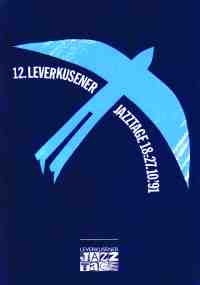 Particell da Requiem
Particell da Requiem
by Ulrich Blomann
Gesine van der Grinten, mezzo-soprano; Tom Mega, voice; Martin Fredebeul,
bass clarinet; Hans-Joachim Hessler, piano; Ulrich Blomann, saxophone;
Peter Eisold, percussion, computer; Kai Struwe, bass; Mirjam Hardenberg,
Susanne Ostermann, Dirte Gläsel, violoncello; R. Zeranski, M. Muellbauer, H.J.
Heisenburger, double bass; chamber choir »cantico novo«
Director: Volker Buchloh
October 20, 1991
12th Leverkusen Jazz days
A sofar »unheard« instrumentation with soprano-solo (Belcanto), chamber choir, electronic instrumentation, computer and the »classic« instrumentation of a jazz quartet, completed by six lower string players,
a bass wind section and an additional percussionist, resulting in vital and absorbing music, the music of Ab-Art, the Particell da Requiem.
Free improvisations of chamber choir and of the Belcanto-lady, a classical bass solo on a marching rhythm of wasteyard sounds, opera-like choir tuttis, collective improvisations which result in chaos, gentle duets, vital solists,
while the sound language ranges from computer-lead electronic to a leaning on Gregorian music…
Video
Trio Hessler/Werni/Wallmeier
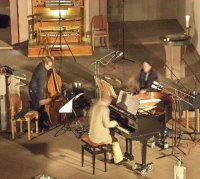 Hans-Joachim Hessler:
Hans-Joachim Hessler:
Der Tanz auf dem Vulkan [Dance on the Volcano]
2006
Hans-Joachim Hessler - organ, piano
Stefan Werni - double bass, virus-synthesizer
Klaus Wallmeier - percussion
The piece "Dance on the Volcano" should demonstrate that intensive and dance-like music is still today able to create subversions and to address political issues. The piece starts with a yodeler which is followed by a laendler. The dance on the mountain, if one so wishes. At first, pure happiness is expressed here. However, the mountain contains sources of danger.
At the end of the day, the volcano is also a mountain: a mountain which is seething on the inside; for centuries, everything can be peaceful, until the breakout occurs. This can be understood as a metaphor for the musical breakouts which follow the laendler. Twice in the course of the piece, the flamenco appears.
This probably most fiery amongst the European folk dances has a fast and virtuosic sound and an elegy which is introduced in its theme by the double bass. The spiritedness and liveliness of the flamenco is contrasted, in the sense of a death dance, with Camille Saint-Saëns' "Danse Macabre".
If nothing else, the "Dance of Salomé", which needs to be understood as the program of this dance section, shows that even her ghoulish game with the head of John the Baptist holds an erotic component. And speaking about eroticism, one particular dance mustn't be left out: the tango. After a crude fortissimo, this one opens out into a quiet percussion solo.
Alongside these, passages which remind of the aleatoric style of John Cage can frequently be heard. A musical reminiscence of Thelonious Monk completes the piece of work.
FLAX-TRIO
 The Flax-Trio was founded during the summer of 1987 with the intention of bringing together three experienced jazz musicians to create a new concept of chamber music. With pleasure, the boundaries between completely different musical styles are torn down; these are then decomposed into single pieces, are absorbed and brought back to the listener in entirely new forms.
An important impetus was the music of Jimmy Guiffre. Further, there are many influences from the afro-American music tradition, as well as from the newer European improvisation music. The eschewal of the usual percussive instrument places the musician in front of new rhythmical tasks, as well as providing opportunities for differentiated chamber musical sound mesh works.
The Flax-Trio was founded during the summer of 1987 with the intention of bringing together three experienced jazz musicians to create a new concept of chamber music. With pleasure, the boundaries between completely different musical styles are torn down; these are then decomposed into single pieces, are absorbed and brought back to the listener in entirely new forms.
An important impetus was the music of Jimmy Guiffre. Further, there are many influences from the afro-American music tradition, as well as from the newer European improvisation music. The eschewal of the usual percussive instrument places the musician in front of new rhythmical tasks, as well as providing opportunities for differentiated chamber musical sound mesh works.
Organ and Percussion
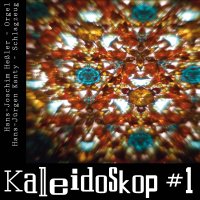 Hans-Joachim Hessler:
Hans-Joachim Hessler:
Kaleidoskop #1
1999
Hans-Joachim Hessler, organ
Hans-Jürgen Kanty, percussion
»The […] introduced piece [Kaleidoskop #1] lives to a great extent off the improvisations of both musicians who harmonised excellently. If one describes Joachim Hessler's means of creating sound as unusual, then the only adjective left for Hans-Juergen Kanty's way of playing is ‚loony'. […]
However, the complete dedication, for instance, during his vowel improvisations or his version of a natural Leslie effect (an approximately three feet long hose into which he sang, while the other end whirled in circles through the air) were partly very amusing and the […] visitors could often not avoid smiling.
In terms of purely technical aspects, both musicians were absolutely beyond any form of doubt and laughter. To those who followed the rampant […] high-speed solos […], it quickly became clear that we were dealing with two excellent musicians« (Dorsten newspaper dated October 11, 1999).
»Joachim Hessler's ›Kaleidoskop #1‹ [...] confronted [...] courageous members of the audience with sound experiments which occasionally led to the question whether or not what was being heard was still within the field of music.
Obviously however, Joachim Hessler holds the assumption that, next to eclectically combined, free quotations of other styles, genres, pieces of work or composers, 'postmodern' music may or must also combine itself with components that do not belong to the traditional language of music:
especially the ›percussion part‹ of the composition with ›singing hoses‹, all sorts of rattling, swinging and clanking equipment […] arrested a lot of attention, partly also causing unbelieving smiles. […]
The best remedy for our desire to define art is - this the music of this night […] showed - obviously art itself: it eludes well-known categories, breaks again and again with habit and helps those who have settled all too comfortably on the cushions of their taste to make a new start« (Borken newspaper dated October 12, 1999)
Live recording of the concert available as CD
The desire to generate suspense
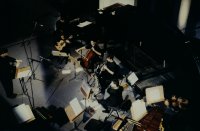 A cycle of five compositions with six sound examples of seven pendulums
A cycle of five compositions with six sound examples of seven pendulums
by Ruediger Beckemeier
1990
with Hans-Joachim Hessler, piano
The composer Ruediger Beckemeier on his cycle The desire to generate suspense:
»Part III [...] – a very tense, complex, polyphone sentence that veers between constriction and courageous raising-up.
The middle part is a scherzo which holds clown-like and grotesque traits.
Part IV [...] – a nature idyll.
The summer wind (flute) creates waves in a small lake (marimbaphone), in which the light is reflected (guitar). Frequently, however, the musical action becomes independent and spontaneously follows different associations.
The middle part here is an expression of pure zest for life.«
Hessler/Werni
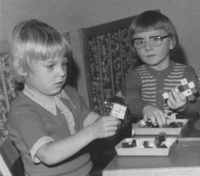 The pianist Hans-Joachim Hessler and the double bass player Stefan Werni made acquaintances back in kinder garden.
There, they played together with toy blocks and lego pieces. They held their first real-book-session in their parents' party basement, and later performed together for the first time at approximately the age of 17 in the Altstadtschmiede in Recklinghausen (Germany).
About 12 years later, on June 28, 1997, the live recording of a concert in the Fritz-Henßler-Haus, which took place in the context of the jazz festival of the University of Dortmund, came into existence - which is available at NonEM-Records with the title Continuum contra Punctum.
Stefan Werni studied double bass at the Music Academy of Cologne. He became one of the most outstanding German jazz double bass players.
The pianist Hans-Joachim Hessler and the double bass player Stefan Werni made acquaintances back in kinder garden.
There, they played together with toy blocks and lego pieces. They held their first real-book-session in their parents' party basement, and later performed together for the first time at approximately the age of 17 in the Altstadtschmiede in Recklinghausen (Germany).
About 12 years later, on June 28, 1997, the live recording of a concert in the Fritz-Henßler-Haus, which took place in the context of the jazz festival of the University of Dortmund, came into existence - which is available at NonEM-Records with the title Continuum contra Punctum.
Stefan Werni studied double bass at the Music Academy of Cologne. He became one of the most outstanding German jazz double bass players.
Continuum contra Punctum: Karl-Heinz Stockhausen writes in the preface to his work
Counter-points: »The ›counter-points‹ [...] have arisen from the imagination
that in a multifaceted world of sound with individual tones and relationships of time, the opposites
should be reconciled in such a way that a state is reached in which only unity […] is hearable«.
Continuum contra Punctum ties in with Stockhausen's piece of work, in order to show by means of a, compositionally speaking,
technically similar transposition that the state of unity is not only unreachable, but shouldn't be aspired in the first place.
In opposition to Stockhausen, Hessler contrasts the punctual organization of violin, double bass and piano with a continuous
organization of the marimbaphone. The marimbaphone tries to maintain the state of unity, however the »continuum« becomes frail and finally disappears altogether.
What is left are the »points«, which win the conflict between »continuum« and »punctum«, since only they are able to be an event
and in this sense are in the position to overpower spirit. Spirit, on the other hand, quickly captures and sees through the »continuum«
which is unable to unleash an improvisation and fails. In the middle part, an extensive marimbaphone-solo exemplifies the essence of the
conflict between »continuum« and »punctum«.
Tonal regulation system 189: The title of this composition has been chosen in leaning on the terminological system of the French philosopher Jean-François Lyotard.
A tonal regulation system therefore would describe a system of rules for a form of discourse with 189 bars.
This »tonal regulation system« takes its sounds from the »sound universe«, which contains everything hearable.
The composer assembled the tones to form four modes of discourse, which are in conflict with one another.
The modes of discourse stand next to one another in an incommensurable way and actualize one another in an unforeseen manner, that is to say,
in a way that is not hearable in advance and in this sense is not a happening. Only at the end of the composition, the different forms of discourse meet,
however this occurs only because the composer finds himself in the ongoing dilemma that his compositions cannot continue endlessly.
The further actualization of the discourses cannot take place continuously, but always only in the following composition.
Hessler, Werni & Jendreiko
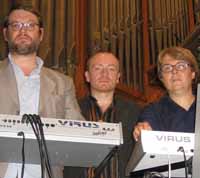 D.A. - Microelectronic and Mechanical Movements
D.A. - Microelectronic and Mechanical Movements
2007
Hans-Joachim Hessler - organ, various percussion instruments
Stefan Werni - Virus Redback, Virus TI and Yamaha DX7 Synthesizer, 1/4 violoncello
Christian Jendreiko - Virus Indigo Synthesizer, Hohner SG 57 electric guitar
The initials »D« and »A« in the title symbolise the digital and the analogue. In the sense that the analogue and the digital frequently stand in opposition
to one another as warmth and the organic on the one hand, and the cold, inorganic on the other - both sides here unite and form a synthesis.
Especially the church organ as purely mechanical instrument represents the analogue side. In addition to this, there are various percussive instruments and a children's cello.
Three Virus-synthesizers and a Yamaha DX-7 are employed as digital means of creating sound. It hereby becomes clear that the organ frequently sounds like a synthesizer and the synthesizer like a mechanical music instrument.
It becomes impossible to distinguish between digital and analogue. The digital mutates and becomes, as the analogue has at all times, the musician's body prosthesis, an organic instrument.
In Varèse's pioneering piece »Poème Électronique« of 1958, a church organ is also employed. He confronts the organ with the electronic sounds of that time.
By electronically estranging the organ, Varèse achieves, as far back as during the 1950s, a synthesis of the mechanical and the electronic.
Today, the sounds are no longer produced by tubes and so on, but instead by microchips. The goal of »D.A.« is to advance Varèse's experiment with today's means of microelectronics.
This is what the subtitle »Microelectronic and Mechanical Movements« points to. In addition, further analogue-digital barriers are removed:
while the cello functions as a border crosser between two worlds, in the process of digitalizing the analogue instrument with a Virus-synthesizer, the electric guitar overcomes the abyss between the mechanical,
the electric and - by means of the also digital sound synthesis of the synthesizer - the electronic.
